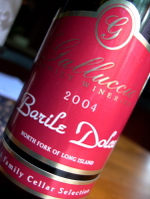
Merlot is clearly the king of Long Island wine. Sometimes it’s the only grape we hear about. It’s the most planted variety and, in the hands of the best winemakers, consistently leads to many of the region’s best wines. But what else is out here on the East End?
Sure, there’s a bay full of chardonnay, made in any number of different styles, and there’s cabernet franc, the often-dismissed variety of Bordeaux. But the wines that too often get lost in the tasting shuffle are the delectable dessert wines. Think you don’t like dessert wines because they are too sweet/heavy/syrupy/high in alcohol? Not so fast. There are world-class dessert wines made right in your backyard that aren’t any of those things. You need only look for them.
And on occasion you really do need to look for them. Because dessert wines can be expensive, up to $50 or more for a 375ml bottle, many wineries don’t pour them in their tasting rooms as part of the usual flight, if at all. But, if you ask, and there is a bottle open behind the tasting bar, you just might get lucky.
Most of Long Island’s best after dinner sippers are made in the style of ice wine or Eiswein, a style of wine that originated in 18th century Germany. In traditional Eiswein, grapes are left on the vines until the first deep frost. When wine grapes freeze, the water is trapped as ice, leaving concentrated nectar that is intensely sweet and flavorful. Most Long Island wines aren’t truly ice wines because the grapes are picked when ripe (typically long before they freeze) and then frozen in commercial freezers before being made into wine.
So which wines are Long Island’s best dessert wines?
Starting on the North Fork’s northern-most wine trail, Sound Avenue/Route 48, Martha Clara Vineyards makes two dessert wines of note. In fact, they may be the winery’s best efforts. The 2004 Himmel ($31),
made from frozen Riesling and Gewurztraminer grapes, is sweet, but
surprisingly light on the palate with layered floral and fruit flavors
and a hint of cotton candy and burnt sugar. Succulent and luscious
today, this wine’s acidity gives it great aging potential. MCV’s other
dessert offering, the 2003 Ciel ($29) is made from Viognier and
Chardonnay grapes. The nose is intensely fruity, with stone fruits like
peaches and apricots, and the palate is sweet and soft with flavors
that closely match the nose.
A few miles east is Macari Vineyards with its 2003 Block E ($36)
– one of Long Island’s best dessert wines. Made using chardonnay and
sauvignon blanc grapes, its nose offers appealing lychee, flowers and
hazelnut aromas. Ripe and rich, it’s filled with honey and tropical
fruits like mango and pineapple on the palate, which aren’t cloying in
the least because of lively acidity and hints of crisp pear. The
elegant finish goes on and on and tempts another sip.
Though just bottled, Castello di Borghese’s 2004 Allegra ($35) is
already drinking exceptionally well. In just its third bottling, this
chardonnay-based wine strikes the perfect balance between fruit, sugar
and acidity. Ripe with peach aromas and flavors, it is intense yet
fresh and supple. Again, tremendous acidity will give this wine
longevity.
At the eastern-most tasting room on Route 48, you’ll find the first release of Waters Crest Winery 2004 Night Watch ($45),
a small-production dessert wine made with frozen Gewürztraminer,
Riesling and Chardonnay grapes. It is named “Night Watch” because
winemaker Jim Waters did just that – watched it all day and night for
four full days without a minute of sleep. The result is a rich,
intricate dessert wine that is sweet, but with just the right delicate
acidity to keep it from being heavy. It’s filled with apricot and
tropical fruit aromas and flavors with just a hint of vanilla.
Moving our tasting tour south a block to Route 25, it’s nearly impossible to exclude Corey Creek Vineyards Raspberry Wine ($19).
Made by combining grape spirits with fresh raspberries, this rich,
almost syrupy dessert wine can best be described as tart raspberry
puree with a kick. Its nose, taste and finish are all powerfully
raspberry – fruit, jam and pie. Drink it by itself or add a splash to
vanilla ice cream for an adult sundae.
Pellegrini Vineyards Finale Bin 1331 ($26),
is a deep golden-hued wine made from frozen Gewürztraminer and
Sauvignon Blanc grapes. Even with the smallest of pours, its rich
aromas burst from the glass with lychee, honey and candied orange peel.
Bright acidity cuts through the considerable sweetness, keeping it from
being cloying, while honey, citrus and vanilla flavors fill and mingle
in the mouth. One should always be careful not to over-chill dessert
wines, but it’s particularly true with this one.
Galluccio Family Wineries calls their 2004 Barile Dolce ($30)
a “merlot frost wine” because it is made with 100 percent estate grown
merlot grapes that are frozen for two months before pressing. While it
features some of the apricot character like an ice-style wine made from
white grapes, it is unique in that it offers some light berry nuances
as well. Interesting and unique, it also seems less sweet when compared
to the rest of the wines listed here.
The South Fork’s lone dessert wine of note is Wolffer Estates’ 2004 Late Harvest Chardonnay ($35).
Given winemaker Roman Roth’s German roots, it should come as no
surprise that he does great things with late harvest wines. The nose is
lightly floral and filled with ripe peach and apricot aromas. This
stone fruit character carries over to a light, fresh palate, with
balanced sweetness and superb acidity.
Drink any of these with your favorite dessert, with robust cheeses
and paté, foie gras or even by themselves. You just might realize that
you like dessert wine after all.
